MXA RACE TEST: THE REAL TEST OF THE 2019 YAMAHA YZ450F
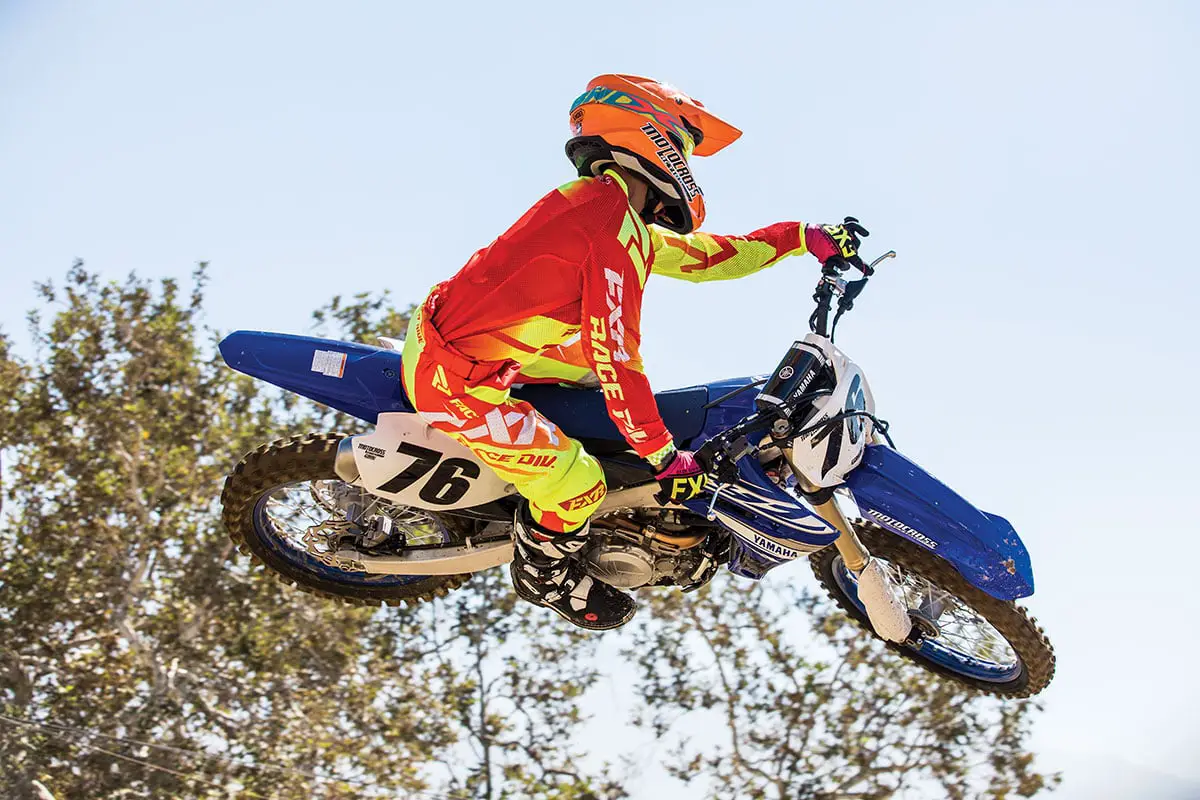
Q: FIRST AND FOREMOST, IS THE 2019 YZ450F BETTER THAN THE 2018 YZ450F?
A: Make no mistake about it, our initial inclination was to say no. Why would it be better? It is basically the same bike as last year, although credit should be given to the 2018 Yamaha YZ450F for being totally new. But, the list of updates for 2019 is short—very short. It consists of updated Kayaba SSS suspension valving, more rigid fork lugs, stiffer wheel collars, less drag on the electric starter system, denser seat foam and a blue valve cover. Not a rousing list of eye-poppers. So, we were surprised to discover that this meager list of changes actually improved the 2019 Yamaha YZ450F way beyond our expectations.
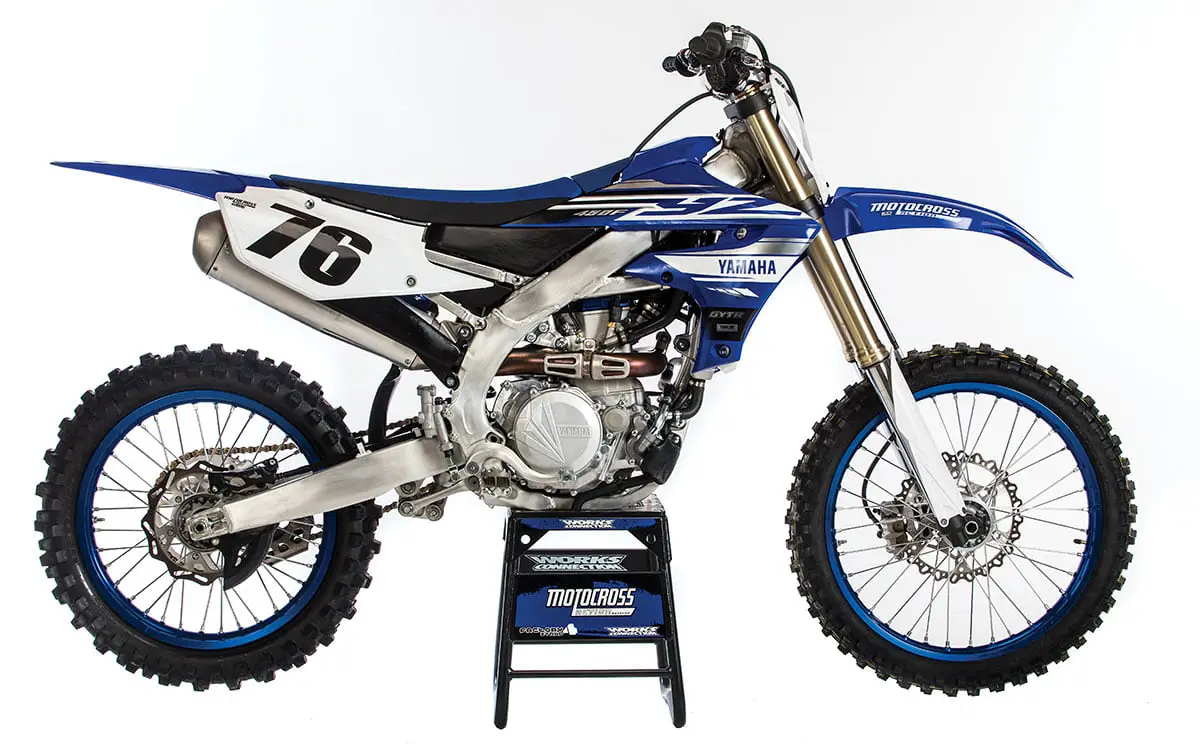
Q: HOW DID THE 2019 KAYABA SSS SUSPENSION PERFORM?
A: Every MXA test rider loves Yamaha’s SSS suspension—and we have been proclaiming our love for the last 12 years. We applaud Yamaha for finding something that works and sticking with it. Prior to 2006, Yamaha had hopped on a lot of fork-idea bandwagons—from AOSS to bumper forks to position-sensitive designs to all the latest, greatest ideas. But once Yamaha’s engineers found the holy grail of SSS, they never strayed from the path. When the air-fork phenomenon hit in 2013 with Kayaba Pneumatic Spring Forks (PSF) and progressed through Showa SFF-TAC air forks and PSF-2 forks, Yamaha’s R&D department never cracked, even when they were under tremendous pressure from the sales department to switch to air. Kudos to the guys in the Yamaha workshop for fighting the good fight. It took over four years, but the decision to stick with coil springs over air was proven right when every brand (save for KTM and Husqvarna) dropped its air forks (under pressure from their sales departments).
Yamaha’s test department was right all along, but being right doesn’t do you a bit of good when the buying public demands air forks and you don’t have them (even though Yamaha had the first production air forks back in 1976). MXA’s love for Kayaba SSS forks was little solace for Yamaha’s in-house test riders, as they suffered the outrageous slings and arrows of the front office.
Since 2006, Yamaha has had the best forks on the track. Would you be surprised to learn that now that every Japanese manufacturer has returned to the coil spring fold, Yamaha still has the best forks on the track. Even more interesting is that if you were rating production fork performance for 2019, the Yamaha is first, KTM/Husqvarna second and Honda, Kawasaki and Suzuki bring up the rear.
There are no drastic changes to the YZ450F’s Kayaba SSS suspension for 2019—just a little tweaking, some new valves and a stiffer shim stack. Those tweaks do wonders for the YZ450F by making the whole set-up firmer. The forks stay higher in their stroke, especially under heavy braking, yet feel plush when they move. They don’t “blow through” in the mid-stroke and seem to be devoid of harshness. These are the perfect coil spring forks —they follow the ground, don’t dive excessively, resist bottoming and, most of all, work for everyone from Vet Novices to AMA Pros. Take our word for it, there is a setting on the 2019 Yamaha YZ450F suspension to fit everyone—fast or slow, fat or slim. Great job.
Q: WHAT IS THE BIG DEAL ABOUT THE WHEEL SPACERS OR THE FORK LUGS?
A: Many years ago Yamaha removed its Yamaha Energy Induction System (YEIS) boost bottles from its production bikes, even though Yamaha admitted that they helped the midrange of their two-stroke engines. When MXA asked them why they took the boost bottles off, especially given that they worked, Yamaha’s test engineer said, “We wanted new wheel collars, and the budget wouldn’t allow both the YEIS and the new wheel collars. We chose the wheel collars.”
The strength, design and rigidity of the head stays, wheel collars, fork lugs and motor mounts have a noticeable effect on how the chassis performs. In 2015, Yamaha replaced the YZ450F’s aluminum lower motor mounts with steel motor mounts. Then, in 2016, Yamaha exchanged the YZ450F head stays for bigger, thicker and stronger plates. And, in 2018, Yamaha repositioned the head stays lower on the cylinder to change the chassis balance. Don’t think that it is just Yamaha swapping out the rigidity and strength of parts that most riders give little thought to, because in 2017 MXA replaced the stock CRF450 head stays with the thinner stays from the CRF450X (and for 2018 Honda redesigned the CRF450 stays completely). We also took the bolts out of the rear of the CRF450’s Ti gas tank and from the mid-pipe exhaust mounts to allow more flex in the frame. So you see, the effects of small parts can make a noticeable difference at speed.
Which leads us to the new YZ450F wheel collars and axle lugs. We don’t know how big a part the wheel collars play in relationship to the stouter axle lugs, thicker wall diameter of the front axle or the new fork valving, but we do know that the 2019 Yamaha YZ5450F tracks better, holds a line perfectly, increases front-wheel traction, lessens bump steer in braking bumps and gives the chassis a sense of purpose that wasn’t there in 2018.
We really feel that the beefier axle lugs are the real contributor to lessening front wheel twist on the entrance and in the center out of turns, but so few changes were made in 2019, we have to attribute any improvements to those limited changes, thus all hail the stouter wheel collars and wider axle lugs.
Q: WHY DID SEAT FOAM MAKE THE LIST OF 2019 CHANGES?
A: If you ever get a chance, remove the seat from a 2018–2019 YZ450F and look at it closely. It is basically a thin plastic base with about 1 inch of foam on it. It has the least foam of any modern motocross bike made. It would be better suited to a trials bike. The 2018 foam was not only thin, it was spongy. When YZ450F riders landed from jumps, they didn’t just land on the Yamaha seat; they landed on the subframe, bolts and all. Bruising was common. For 2019, Yamaha switched to a 16-percent-denser foam. Not necessarily thicker foam, but a firmer foam that is less likely to collapse when a 200-pound airborne rider lands on it. It is an improvement.
Sadly, we sacked out the new foam in less than 10 hours of riding.
Q: HOW DOES THE 2019 YAMAHA YZ450F RUN ON THE DYNO?
A: The 2018–2019 YZ450F engine package is a major step up from the older 2017 powerband, just not on the dyno. The old engine made a little more power from 5000 rpm to 8000 rpm, while the new engine was better from 8000 rpm to 11,000 rpm. Peak power is 57.55 horsepower at 9700 rpm (that is one pony more than in 2017, while torque was actually down about 1/2 a pound-foot in 2018–2019). But don’t let the numbers make you think that the 2019 engine, which is totally unchanged from the 2018 engine, is not an effective motocross race engine, because it is—in a big way.
Q: HOW DOES THE 2019 YAMAHA YZ450F ENGINE PERFORM ON THE TRACK?
A: We can’t hide the fact that the 2019 YZ450F engine is identical to the 2018 engine, but that isn’t a slam. Most test riders complained about the previous 2017 engine because it had an abrupt hit down low, then laid down from 6000 rpm until 7000 rpm before hitting hard and taking off towards its high-rpm peak. This dip in the powerband made the 2017 YZ450F hard to ride and was largely responsible for the chassis lifting on the exit of turns. We describe the 2019 powerband (and its 2018 cousin) as having been “filled in.” Instead of the dead spot in the middle that broke the 2017 YZ450F powerband into two distinct powerbands, the new engine has one long usable powerband.
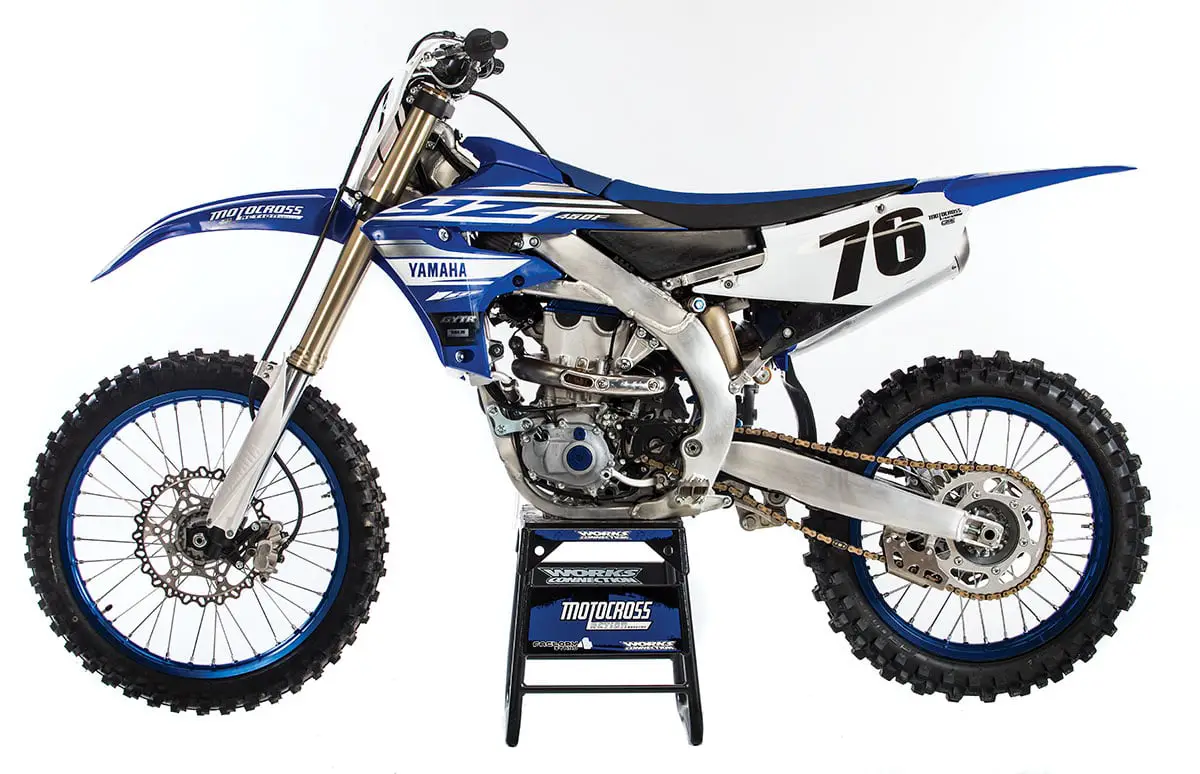
Q: WHAT DID WE CHANGE ON THE 2019 YAMAHA YZ450F ENGINE?
A: We were happy with the YZ450F power but felt that we could improve it with three changes. As luck would have it, the Yamaha engineers embraced a change that we made in 2018 on the 2019 model. Here is the list.
(1) Gearing. Last year we felt that second gear revved out too quickly, only to be met by a sluggish third gear. So, we switched the stock 48-tooth rear sprocket for a 49. We liked the gear ratios a lot better. Gearing it down lessened the workload on second gear by moving third gear closer. Dare we say, it “filled in” the gap between second and third and allowed us to use third most of the time. Yamaha’s R&D department tried the “add one tooth on the rear” solution, liked it and adopted it as the stock gearing on the 2019 model.
(2) Mapping. We don’t like the stock YZ450F map. It felt lean and a little flat down low. To tell the truth, we thought that Yamaha would install the Travis Preston mp that we ran last year in the 2019 YZ450F. They must have had a bad Wi-Fi connection at the Yamaha factory because they didn’t. No sweat, the Preston map is appreciably better than Yamaha’s existing map. When we re-dynoed our YZ450F with the Preston map instead of the stock map, it made more horsepower and torque at every spot on the curve. Horsepower was up by as much as 2 horsepower (torque was up 0.90 pound-foot). Best of all, peak horsepower was moved down from 9700 rpm to 9200 rpm. That 500-rpm difference allowed us to use the existing power more efficiently (without having to keep revving the YZ450F past our bravery limit).
(3) Air filter. We aren’t fond of the 2019 Yamaha YZ450F airbox and air filter design. Yamaha uses a flat piece of foam that lies on top of the backfire screen. Every time the engine pulses, which can be 10,000 times a minute, the air filter vibrates against the wire screen. The constant pulsing and suction dries up the air filter oil and eventually sucks dirt through the dry spot in the foam. The quick fix is to run a Twin Air YZ450F air filter (part number 152221). It features a much thicker foam filter plus a plug-in spacer that lifts the Twin Air filter off the backfire screen to lessen the repetitive pounding against the screen. Twin Air also offers a Power Flow kit that includes a new airbox sealing ring, aluminum cage and air-filter bolt. It accepts a much larger dome-shaped air filter and no backfire screen. If you don’t replace the stock air filter with the Twin Air design, be sure to check it constantly. If you see a white circle in the center of the air filter, re-oil the filter immediately.
Q: HOW DOES THE 2019 YAMAHA YZ450F HANDLE?
A: The $9299 2019 Yamaha YZ450F is a better package. Yamaha managed to make some significant improvements in its previously loose chassis setup with better suspension, more rigidity in the steering axis, a broader powerband and better gearing. This isn’t one of our favorite chassis. It has some quirks in the steering response that put a hitch in its gitty-up. It doesn’t help that the 2019 Yamaha YZ450F weighs 238 pounds. We are embarrassed to say that even at that weight it isn’t the heaviest 450 on the starting line. There is one bike that weighs 3 pounds more (Suzuki RM-Z450) and one bike that weighs the same (CRF450). Just so you know the 2019 YZ450F is a whopping 15 pounds heavier than the KTM 450SXF.
Bulk is the biggest hindrance to the 2019 Yamaha YZ450F being considered an excellent handling machine. It is tall and wide, even if it is lower and narrower than it was in 2017. It feels big and bulky, and riders have to either finesse it or muscle it. There isn’t an in-between that suits most riders. If you push it hard, it will fight you in the corners; and if you try to glide it, it won’t be fast. There is only so much that axle lugs and wheel collars can do to change the personality of a bike with issues.
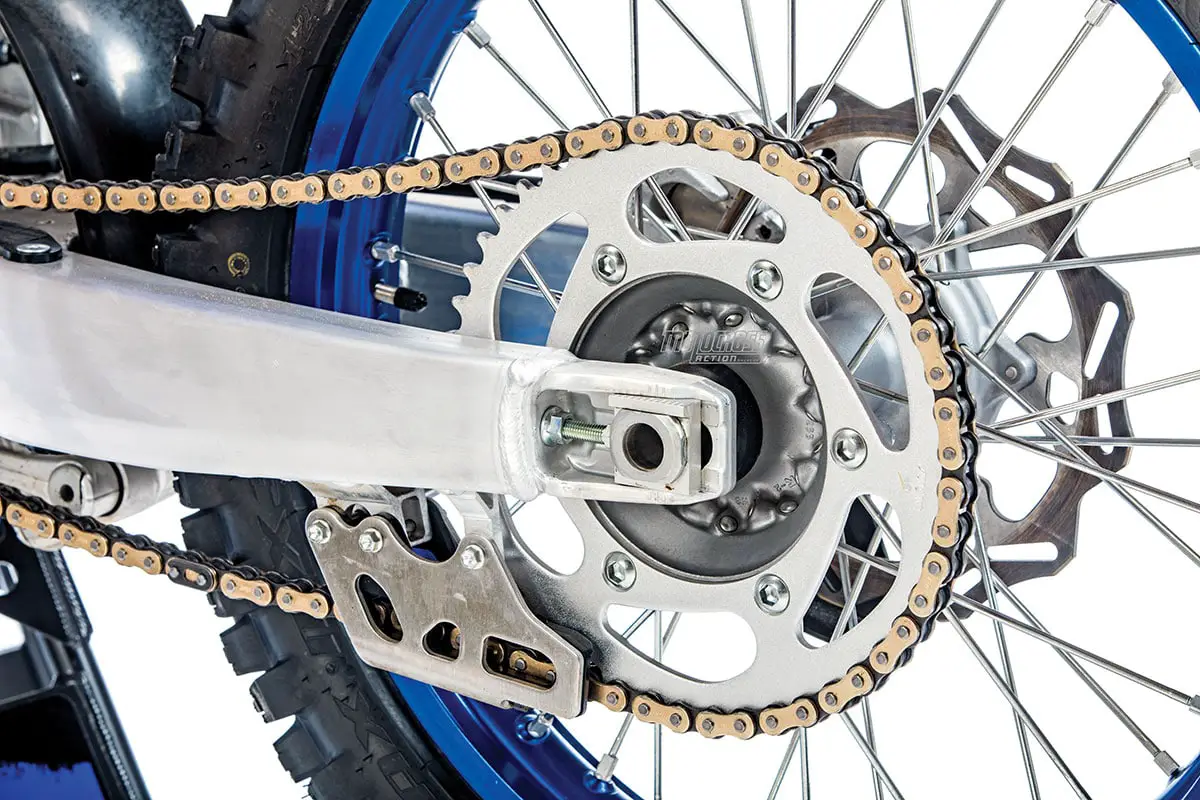
Q: WHAT DID WE HATE?
A: The hate list:
(1) Handlebar height. Yamaha fiddled with handlebar height in 2018 by lowering the seat and raising the bar mounts. We took off the 5mm-taller bar mounts and replaced them with the lower 2017 bar mounts.
(2) Weight. 238 pounds is, at the very least, too heavy. Those extra 15 pounds are a big burden on the brakes, forks, rims, spokes, frame and the rider’s back.
(3) Exhaust pipe. When you put the cylinder head on backwards, the pipe has to go forwards before it can go backwards. Removing the stock exhaust is a pain.
(4) Air filter. The filter should not lie on top of the backfire screen.
(5) Seat foam. Yamaha made a big deal about its 16-percent denser seat foam. We had to replace our 2019 seat after 10 hours because the foam broke down.
(6) Ergos. Even though it is thinner than it was two years ago, it is a big, bulky, wide and heavy bike. It is thin for a Yamaha, but not narrower or thinner than its competition.
(7) Blue rims. We prefer silver rims. Blue rims belong on a TM. Black and blue rims get scratched up by tire irons.
(8) Noise. With the airbox mounted where the gas tank would normally go, there is a lot of noise that wasn’t there when that space was just gasoline.
Get rid of the stock air filter and replace it with a Twin Air unit. Twin Air’s filter is raised up 11mm above the backfire screen.
Q: WHAT DID WE LIKE?
A: The like list:
(1) SSS. Yamaha singlehandedly wiped Showa and Kayaba air forks off the face of the earth. Yamaha has the best coil-spring forks in the biz.
(2) Reliability. Nothing is as reliable as a Yamaha YZ450F. It will last forever.
(3) Wi-Fi mapping. You can remap your 2018 YZ450F with your iPhone. The fuel and ignition grids have 16 boxes each (the old-school Power Tuner only had 9 boxes). You can change the fuel by 2-percent increments and advance/retard the ignition in 1-degree increments.
(4) Cheap R&D. Honda, Kawasaki, KTM and Husqvarna built new bikes‚—Yamaha changed the wheel spacers and fork lugs and made the biggest improvement they’ve made in years to the steering response. Thanks to the axle lugs, it doesn’t wiggle at turn-in.
(5) Plastic pieces. We used to catch our boots on the pointy end of the right-side panel. For 2019, Yamaha put a hook on it to hold it down better.
(6) Clutch. We run stiffer clutch springs just to ensure proper hook up.
(7) Triple-clamp offset. The 22mm offset clamps are standard. Yamaha jumps back and forth between 25mm and 22mm every couple of years. Trail is increased from 118mm to 121mm.
(8) Suspension settings. The suspension settings were developed in the USA and are now the worldwide settings.
(9) Gearing. Last year, we switched the stock 48-tooth rear sprocket for a 49. For 2019, Yamaha adopted the “add one tooth on the rear” solution.
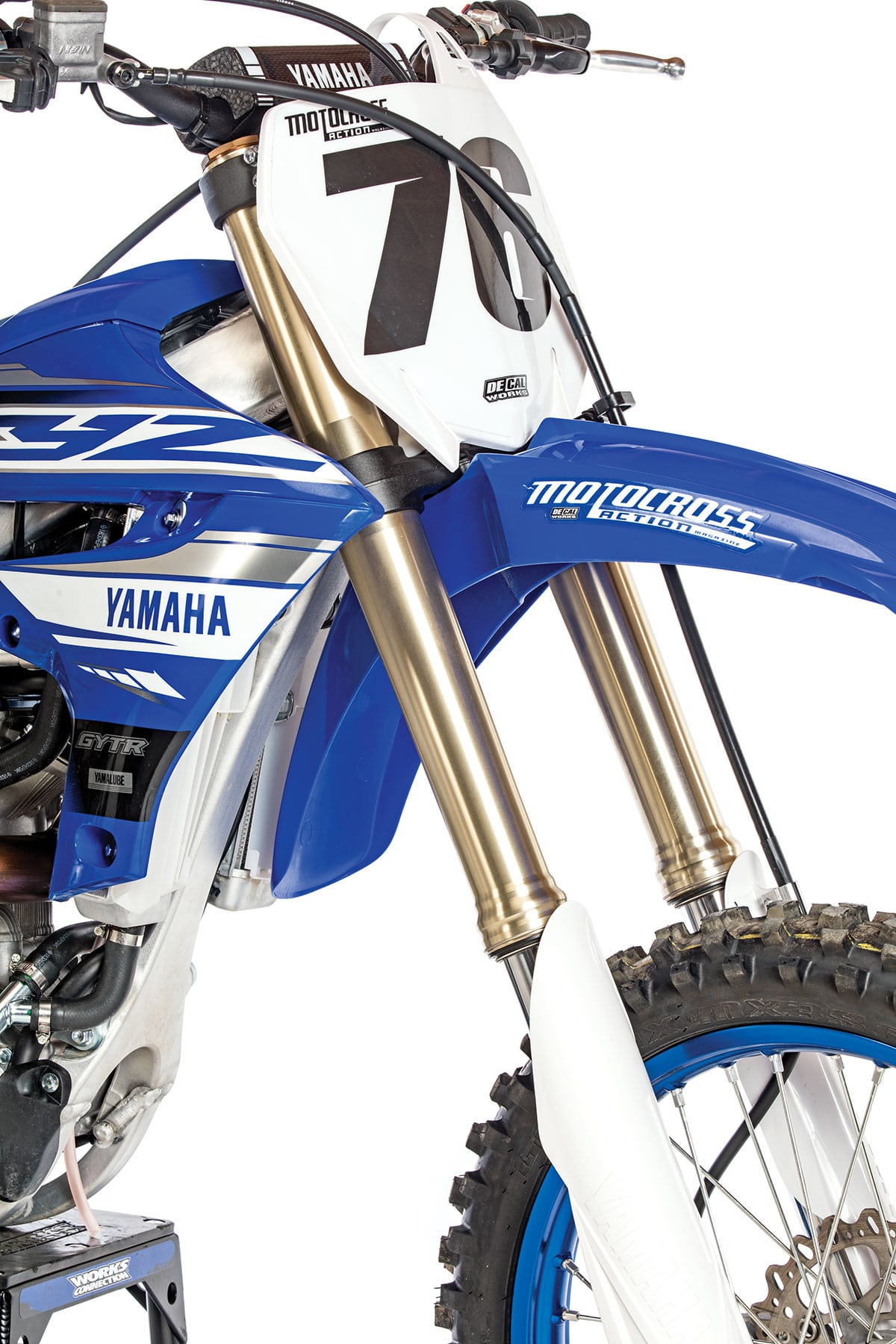
Q: WHAT DO WE REALLY THINK?
A: With no budget for 2019, the YZ450F could have been expected to stagnate until the bosses freed up beaucoup bucks, but we give the Yamaha engineers props for improving the 2019 YZ450F without raising the ire of the pencil pushers. They made practical mods that actually did something. It’s a better YZ450F with only three wheel spacers, a bigger rear sprocket, some fork and shock shims, and a chunk of foam. Oh, yeah, we are discounting the blue valve cover.

MXA’S YAMAHA YZ450F SETUP SPECS
This is how we set up our 2019 Yamaha YZ450F for racing. We offer it as a guide to help you find your own sweet spot.
KAYABA SSS FORK SPECS
Yamaha’s SSS suspension is a sure thing. It was the best fork back in 2006, and it has stayed on top of the heap with minor tweaks every couple of years. Maybe someday the coil-spring forks of the green, yellow, and red bikes will catch up to SSS, but not in 2019. For hardcore racing, these are MXA’s recommended 2019 Yamaha YZ450F fork settings (stock settings are in parentheses).
Spring rate: 0.50 N/m
Oil quantity: 290cc
Compression: 9 clicks out (8 clicks out)
Rebound: 8 clicks out (10 clicks out)
Fork-leg height: 5mm up
Notes: For 2019, Yamaha has refined what were already the best forks on the market. What’s best about them? They work for Beginners, Novices and AMA Pros. They don’t care if you’re thin or fat, tall or short. There’s a setting for everyone. Be very careful with the compression clicker. One clicker is the equivalent of a couple clicks on other brands of forks.
KAYABA SHOCK SETTINGS
On the track, the shock settled a lot better than it did last year. It didn’t wallow as much thanks to stiffer mid-speed valving. Most MXA test riders went out on the high-speed compression to soften the feel on square-edged bumps. The rebound could be made to work by going one click in either direction. We used the rebound to settle the chassis, especially on the entrance of corners. For hardcore racing, these are MXA’s recommended 2019 YZ450F shock settings (stock settings are in parentheses).
Spring rate: 58 N/m
Race sag: 105mm (100mm stock)
Hi-compression: 1 turns out
Lo-compression: 12 clicks out
Rebound: 11 clicks out
Notes: We thought the 58 N/m shock spring was going to be too stiff for slower and lighter riders, so we had the 2017 56 N/m spring with us just in case. Amazingly enough, we had riders as light as 130 pounds still get acceptable race sag from the stiff spring.





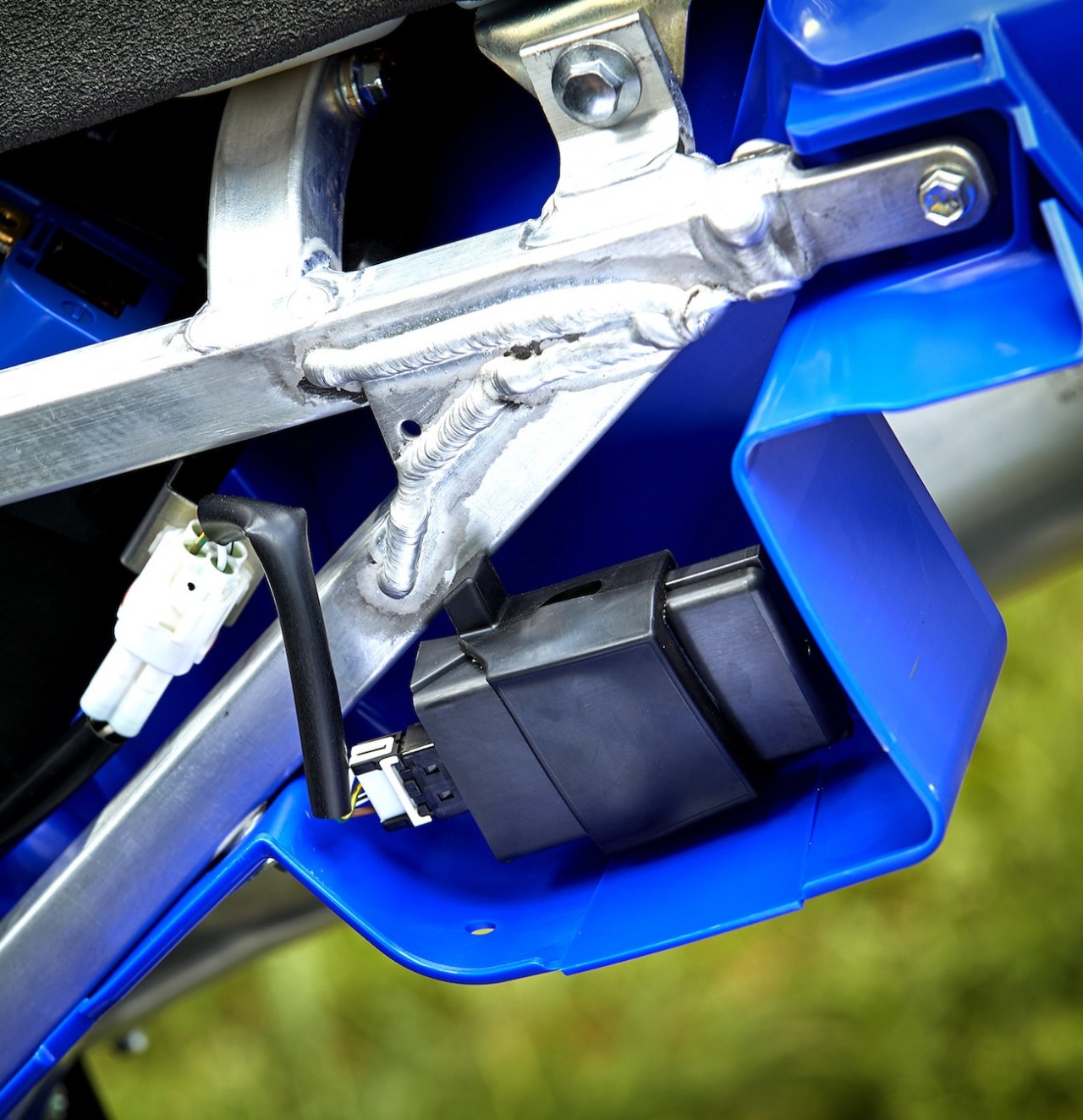
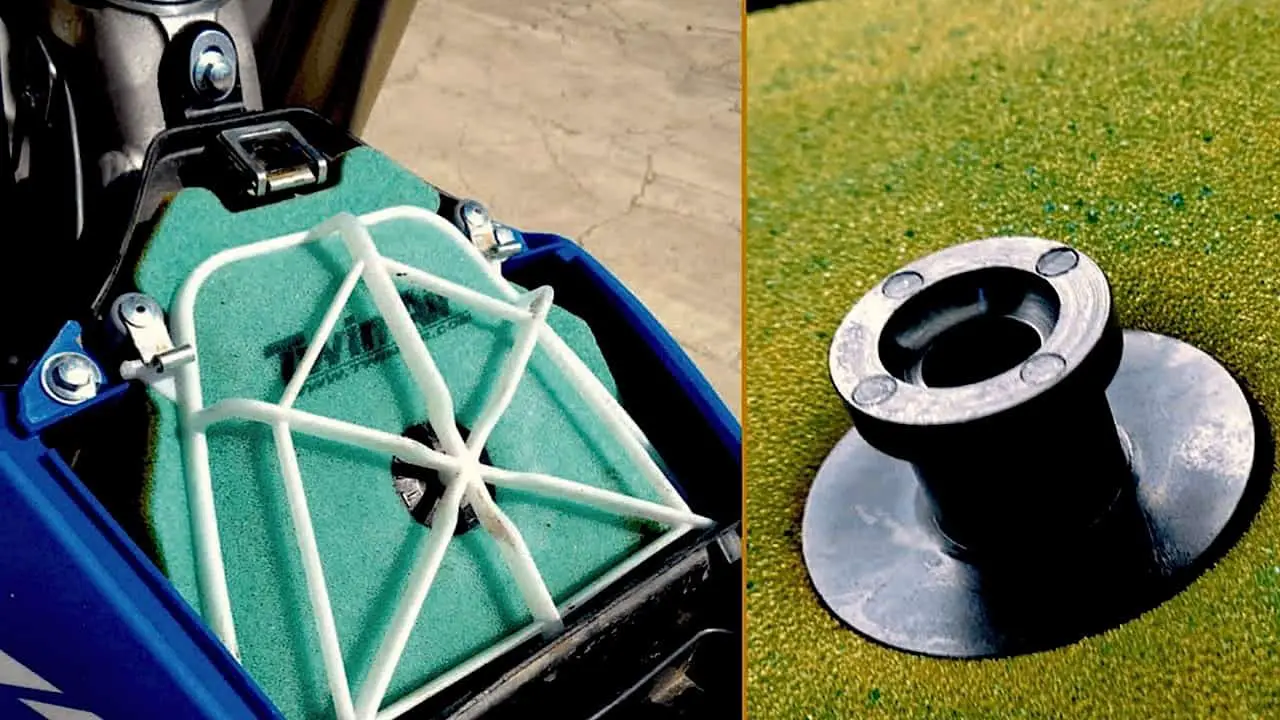
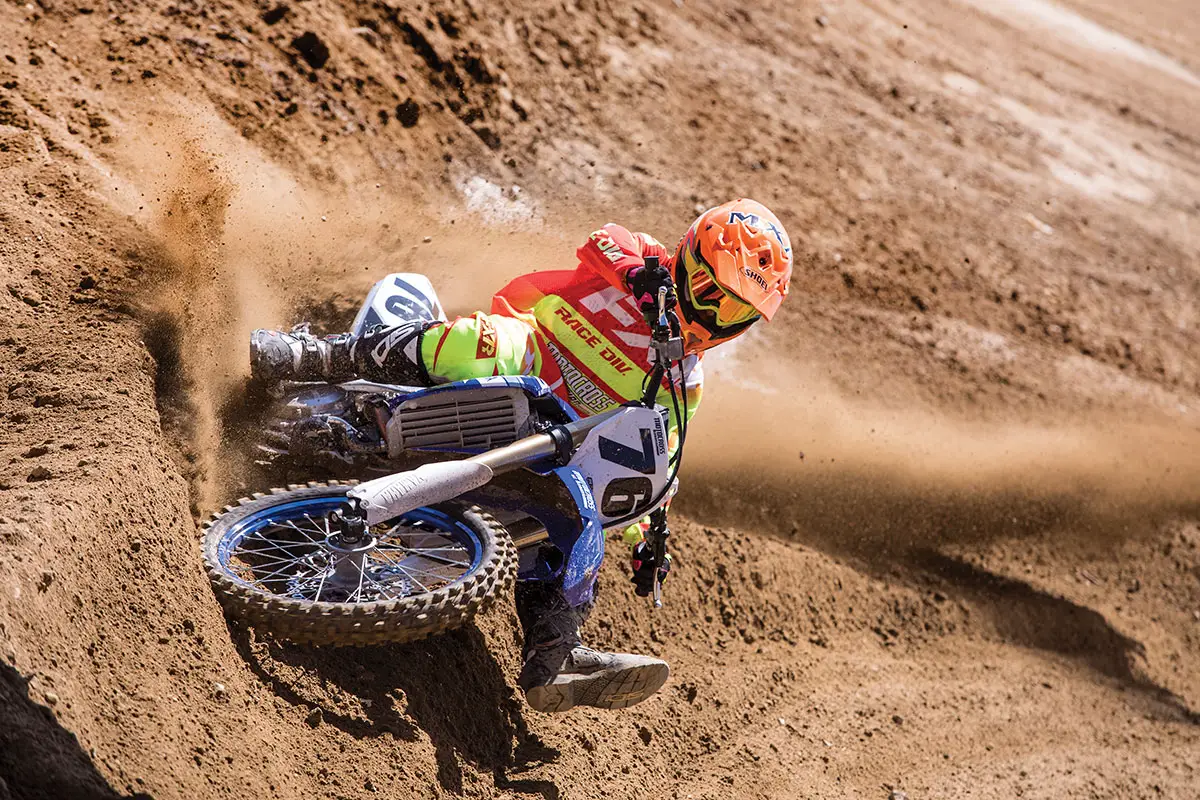

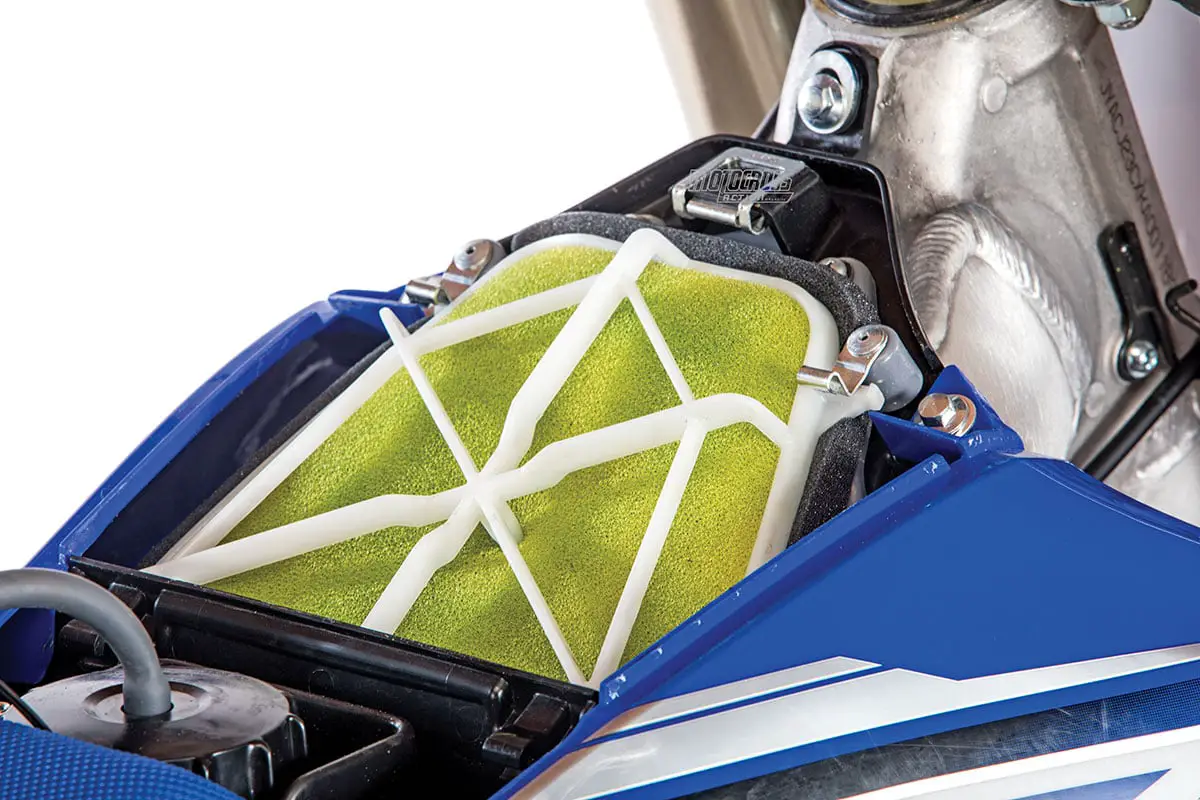


Comments are closed.